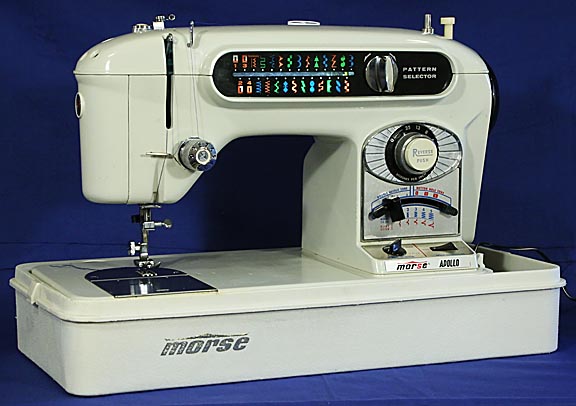

The Story of the May Sisters
By the late 1950's, virtually all sewing machines had evolved to the same utilitarian design we still see today. While practical, this universal sameness has made us forget the golden age of sewing machines, when every manufacturer had unique designs often featuring elaborate scrollwork frames and beautiful illustrations. Come with me as we turn back the pages of time to an era when sewings machines could cost as much as a year's wages and were status symbols as important as Rolex watches and smart phones are today.
The sewing machines shown on this page are part of a collection that started with a machine made in 1885 by the Jones Sewing Machine Company. To reflect its age, style and personality, it was named "Hilda May." As the collection grew, each new machine was given the surname "May" to establish that they all belonged to the same family, and so the "May Sisters" came into being. We'll start with the youngest sister first, then work backward in time.
~ Penny May~

This Morse Apollo 6400 Fotomatic V sewing machine is the baby of the May sisters, barely half a century old. Her retro disco styling makes her one of the most attractive modern machines in the collection. Morse imported machines made in Japan by Toyota and Pine for resale in the US from 1948 through the 1970s. One of the frustrating issues with these machines is that there is virtually no information about when any of the models were released so dating them is almost impossible. After failing to find information about this machine under the Morse brand, I got the idea of searching through Toyota's sewing machine history and struck pay dirt. On the official Toyota website, they have a picture of this machine with the statement it was made for US resale. It was released in 1968 and had the Toyota designation of Z765.
Here's a video of her:
~ Daisy May ~
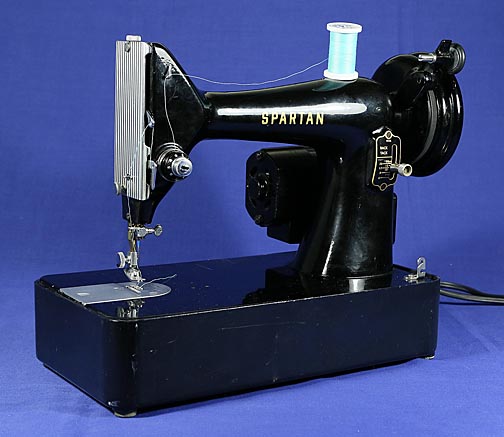
Manufactured in 1958, Daisy May has a form similar to modern machines, but two features mark her as belonging to an earlier era. First: her body is solid cast iron, which doubles her weight over more contemporary machines consisting of as much as 50-percent plastic. Second: she has an external motor. In operation she suffers from both motor and internal noises that make sewing on her a little distracting. Her bobbin and bobbin case are the same as modern machines.
One
oddity about Daisy May as well as all the other antique sewing
machines on this page is that
their
needles all thread from left to right. Modern machines almost always
thread from front to back.
~ Ruby May ~
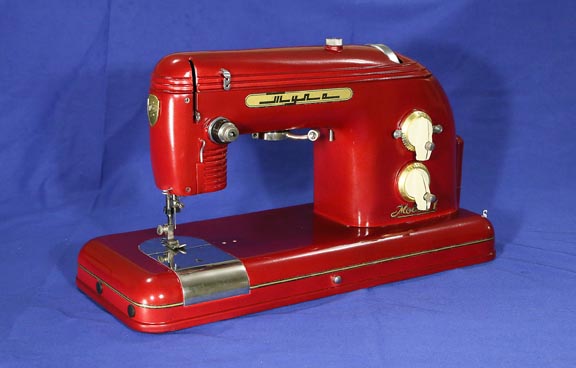
Here we have something very special: the Tula electric/hand crank sewing machine. Made in Russia in 1958 by the Tula Mechanical Engineering Plant, this Model 1, who we've named Ruby, comes with an attachable/detachable hand crank so she can be used in areas without power, something common in Europe in the 1950s. Most come in green or beige, but this one is the rarer maroon, actually more of a candy apple red. For a live action look at this unusual machine, please click on the following short YouTube video:
~ Letty May ~
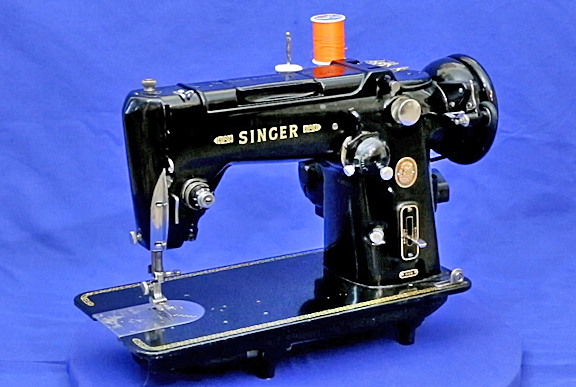
This 1956 Singer 319W causes more fights among sewing machine lovers than any other. Half claim it's one of the worst machines ever made because it's noisy, complicated to use and about as attractive as a boat anchor. The other half don't think it's noisy, find it fun to use and has a endearingly quaint appearance. We like it because it doesn't look like anything else we've seen and exploring its many functional mysteries is a hoot. It features five internal stitch cams and an external cam that can changed out with any of the 30 made for this machine.
~ Anny May ~
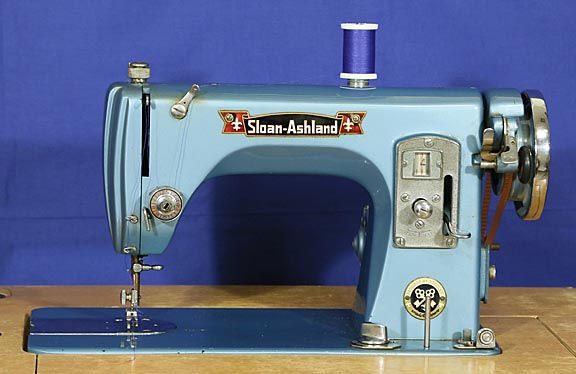
While her form is modern, This 1955 Sloan-Ashland sewing machine has the same cast iron body and external motor of the slightly younger Daisy May. Made by Toyota, the same company that makes cars, this heavy weight sewing machine was popular for many years on sailboats because it could stitch heavy sail cloth. This is one of the hardest machines to locate manuals for. Like Daisy May, her external motor and internal workings run on the noisy side compared to the rest of the machines. While the bobbin and its holder are similar to modern machines, instead of dropping in from the top, they feed in horizontally from the end.
~ Katy May ~
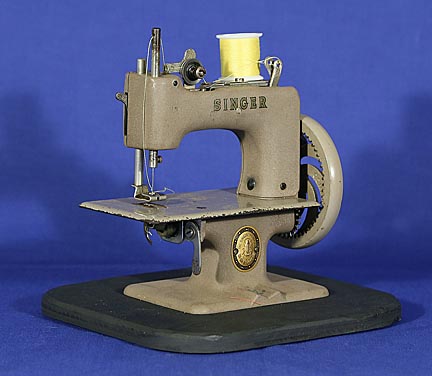
Although classed as a toy, this small hand cranked machine from 1955 produces a tight chain stitch that can be used to sew real garments. The construction is heavy sheet metal on a cast iron base and runs smoothly.
~ Betty May ~
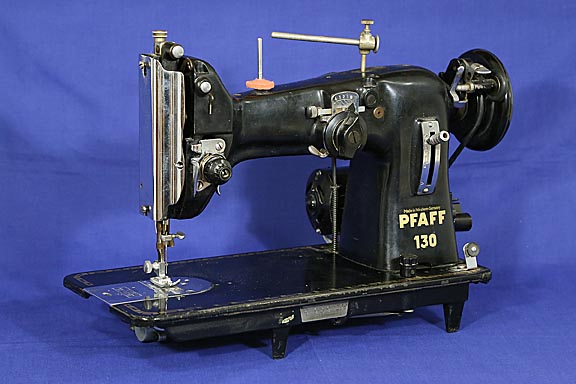
This Model 130 Pfaff is an extremely early zigzag sewing machine, which first appeared in 1932, though this particular unit was made much later in 1954. She's a heavy duty machine that weighs over 35 pounds but feels more like 80. While not the most beautiful sewing machine ever built, over the decades it's developed such an outstanding reputation for reliability that many are still in use today. For many years it was nicknamed 'the universal tailoring machine.'
~ Milly and Molly May ~
(We call them "the twins.")
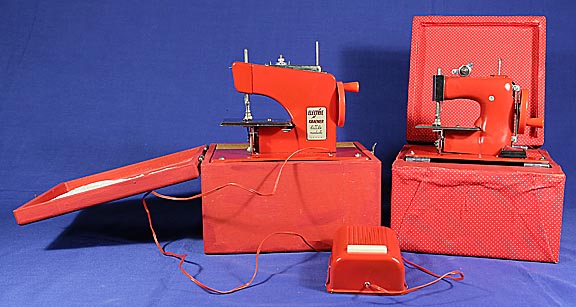
These two battery powered chain stitch sewing machines come from 1953. Sheet metal construction and plastic parts clearly label them as toys, yet here they are over 70 years old and still sewing straight, tight stitches. Their main problem is that they drift out of alignment very quickly. These use needles with round shanks rather than the flat sided shanks used on most other machines. We couldn't locate needles that were short enough so we had to cut off 1/4 inch from the shank of a normal needle to get it to fit.
~ Margie May ~
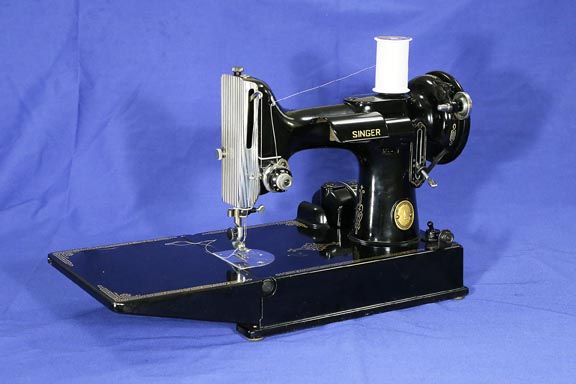
This Singer Model 221 Featherweight sewing machine has become a favorite among vintage sewing machine collectors... and for good reason: it's durable, compact, lightweight, sews great and has a beautiful understated elegance. Margie is in near perfect condition and required no restoration at all. If you want one of these little beauties, it pays to shop around. In recent years they have become highly sought after, which has driven their price up. Many sell for as much as $1,000. But the patient shopper can still find excellent examples for as little as $300.
~ Maggy May ~
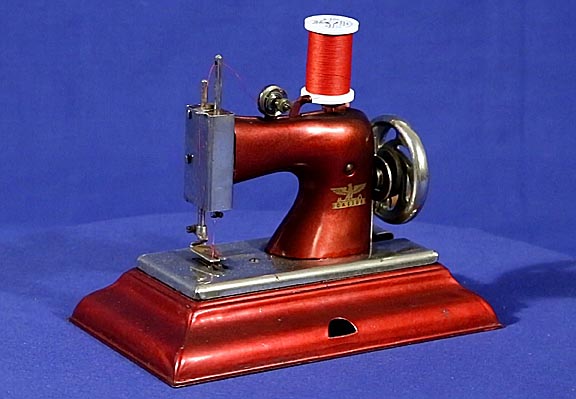
We usually avoid buying two of the same machine, but we couldn't resist the candy apply red of this 1952 Casige, identical in every way execpt color to Rosy, the next machine in our collection.
~ Rosy May ~
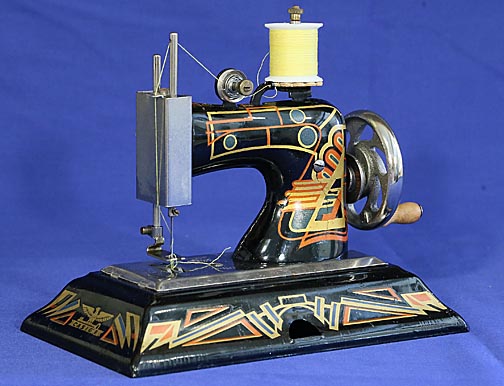
This chain stitching 1946 toy sewing machine was made in Germany by Casige, Muller's main competitor. Dating this to an exact year was made easy by the fact that the needle plate was stamped with "Made in the British Zone," which only existed in Germany for one year following World War II. This manufacture date is a little misleading because the factory converted to war production from 1939 to late 1945. It's doubtful it could have returned to full fabrication capability in under a year. It's more likely that this machine was 'assembled' in 1946 from parts put in storage prior to the war. This art deco design first appeared in the 1920s.
It came with the following box, key, spool and clamp:
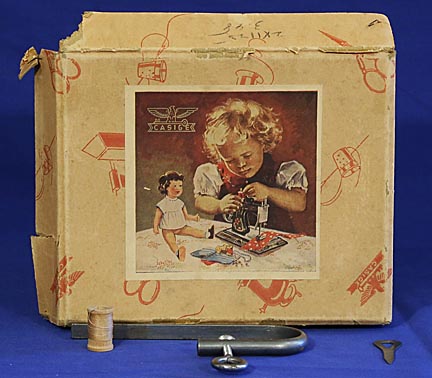
~ Libby May ~
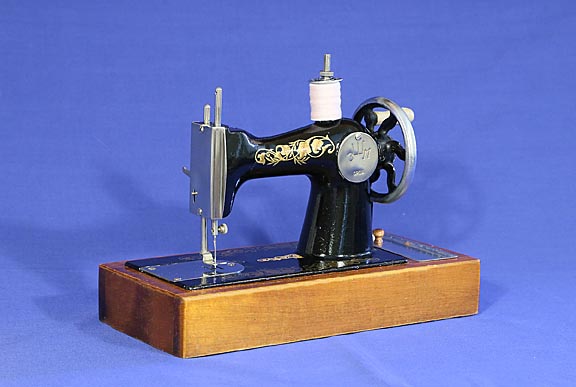
Libby is a toy manufactured in Russia under the 'Orsha' brand name. There is virtually no information available on either the maker or these particular machines. Therefore, dating her is extremely difficult. Browsing through many images, Pinterest and EBAY sales suggest she began life in 1940 because only around that date could we find versions with her particular decal set and black enameled body. Later models feature brighter colors, different decals and more modern lines to the shape of their bodies.
This one is unusual because she has a lid to her small storage compartment. These lids are are only held on by friction and often lost.
We love her because unlike most toys, she has weight and shape of a full size antique sewing machine. She reminds us of a little girl trying to look grown up by putting on her mother's clothes.
~ Maisy May ~
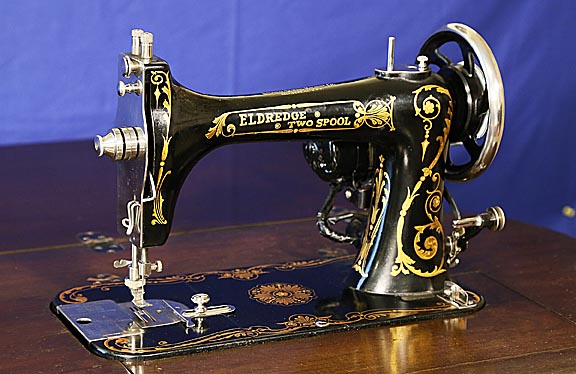
This 1929 Eldridge Two Spool sewing machine was manufactured by the National Sewing Machine Company. What makes her special, besides being in excellent condition, is that instead of a bobbin, the lower thread comes off a number 50 spool held in a canister under the bed. This enables her to sew continuously up to four times longer than bobbined machines. Originally designed in 1913 for a treadle, this later model was factory modified with an electric motor.
As great as the two-spool idea sounds, the idea never took off because the spool holder could only hold one size of spool. At the time there were many different sizes and shapes. The tension was also hard to maintain as the spool thread radius decreased.
For a live action review of this great machine, please click on the following YouTube video:
~ Alyssa May ~
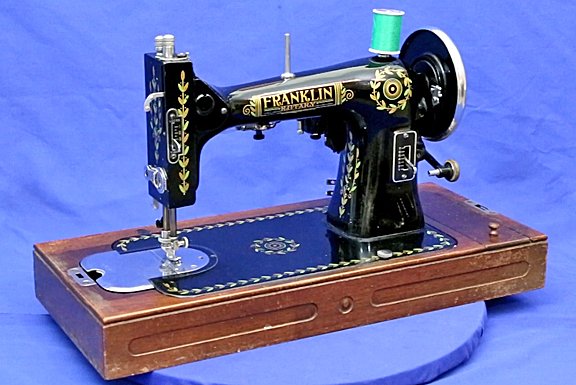
These Franklin Badged machines were made by the Domestic Sewing Machine Company for Sears. She's an electric rotary machine that still sews sweetly. Alyssa first saw the light of day in 1928, which just barely makes her an antique.
~ Nellie May ~
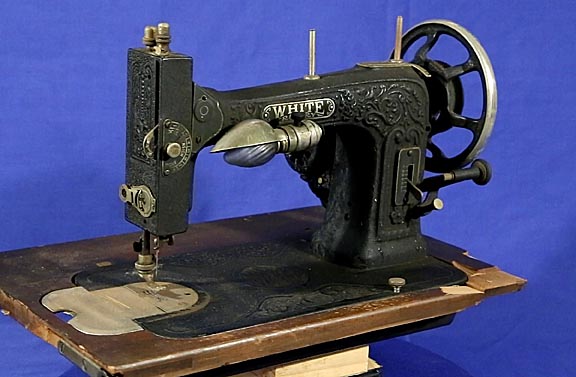
I don't like speaking unkindly about any sewing machine, but the fact is poor old Nellie, a 1927 White rotary sewing machine, weighs as much as a boat anchor and is just about as attractive. We found her collecting dust on the bottom shelf in a small thrift store and even though she was only $35, we almost passed her by. Then two things caught our interest. First, instead of the typical gloss black enamel finish, she sported a dull crinkle coat. This was introduced in the late 1920s as a more durable finish that reduced glare. The finish became a fad and many manufacturers adopted it well into the 1930s, where it eventually faded. The second attraction was that instead of brightly colored decals, Nellie has filigree cast into her body. This makes sense because putting decals on the highly textured crinkly finish would be impossible.
In 1926, White released a limited number of bronze plated versions of this machine. We're considering restoring this machine with that extremely unusual finish.
NEW MACHINE!!!
~ Charlene May ~
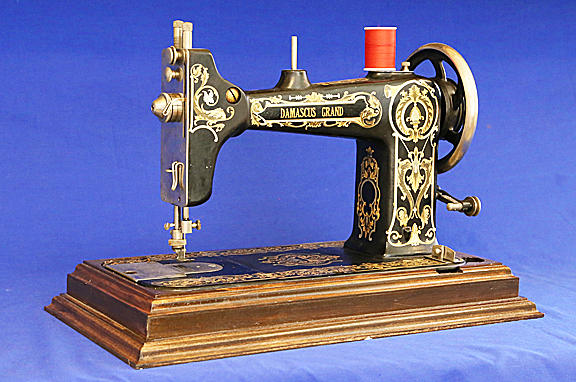
Unlike most National sewing machines, we know exactly that this Damascus Grand sewing machine, made for Mongomery Wards, was made in 1926, because the paperwork that came with her included the original warrenty dated Novemeber of 1926. Upright and substantial, Charlene makes us think of a robust aunt who demands respect.
~ Roxy May ~
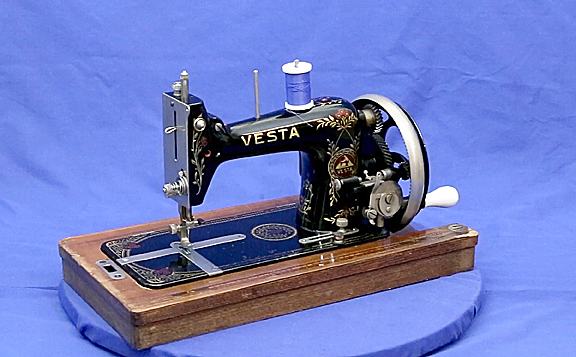
Roxy is a 1920s German made Saxonia Vesta, made by the L. O. Deitrich company. We can't date her any more accurately because the Vesta company was a victem of the second world war and no records survived. She's a cute half-size machine that runs very smoothly because she has angled gear teeth instead of straight spur gear teeth like most machines have.
~ Victoria May ~
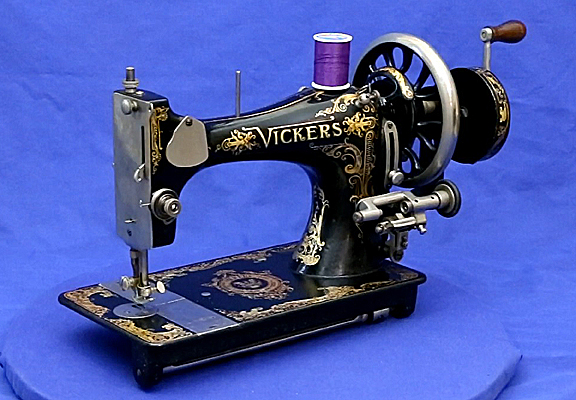
Made by the same famous British Vickers company that made much of the military equipement used in both WW1 and WW2, this 1920s vibrating shuttle machine is a dream to use. She has some of the most beautiful artwork ever put on a sewing machine.
~ Marcy May ~
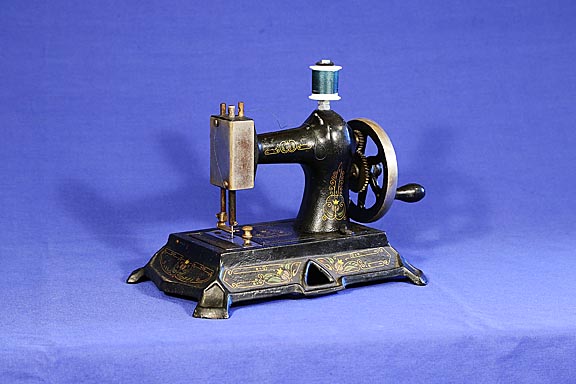
Marcy is a Muller Model 19 toy sewing machine. Her large size, almost twice that of a Singer 20, sturdy base and cast iron construction make her a heavyweight in the toy division. Although German manufacturer Muller made millions of toy sewing machines, there is no information for dating the model 19. Her art deco designs suggest the 1920s so we're pegging her date at 1925. She's in great condition with all her decals clean and unworn. The only small issue is that her shellac finish has begun to crack, which will be an easy fix when she's restored.
NEW MACHINE!!!
~ Rebecca May ~
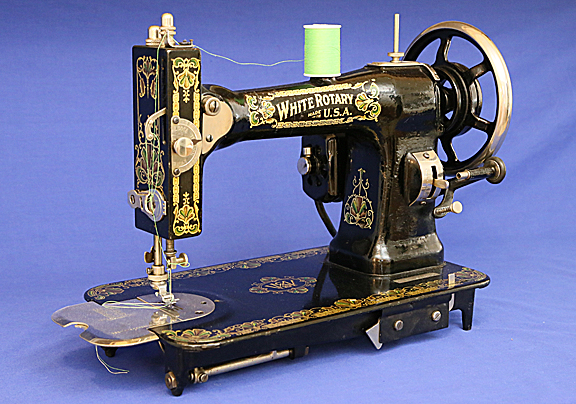
Like many antique and vintage sewing machines, this one is a treadle head, a machine designed to be mounted on a foot driven treadle cabinet. Because these cast iron beauties outlast the wood cabinetry by decades, many end up for sale sans treadle bases. Most can't even stand up straight by themselves. The White Sewing Machine company obligingly cast feet into this model's base so she could. We'll need to make a presentation base for her but otherwise she's in great condition.
The 'rotary' refers to the fact that she uses a modern-type bobbin rotating system instead of the older reciprocating shuttle system. Her FR 3112207 serial number dates her to 1925, so she has a few years to go before graduating from being merely 'vintage' to the more prestigious 'antique.'
~ Patty May ~
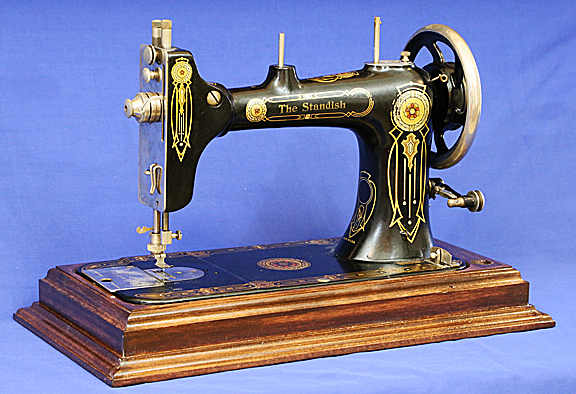
Patty May is a 1920s model A2 National rebadged as "The Standish." National had warehouses filled with completed sewing machines waiting for anyone with a large enough order to request whatever name they wanted placed on them. While there are extensive lists of these badgings and the companies associated with them, we have never found who asked for them to be labeled "The Standish." It may have been a minimum order for a small store. Regardless, Patty is a clean machine that will require minimum restoration. Best of all, this rotary machine still sews great. The following video shows her after restoration and how to use her:
~ Polly May ~
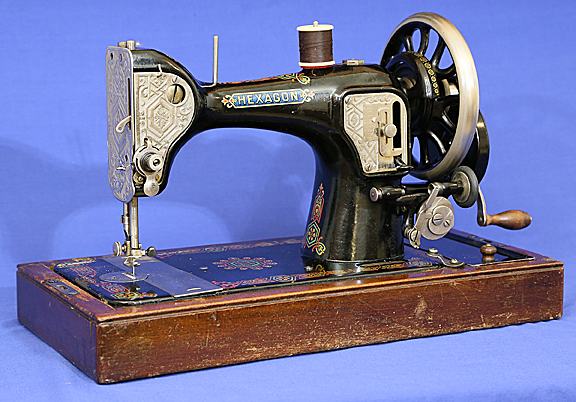
This 1923 Hexagon was manufactered for Sears by the Standard Sewing Machine Co. The same machine with different decals was sold as the Harris No. 5. Standard went into liquidation in 1924 and by 1929 was taken over by the Fredrick Osann Co., which in turn was bought out by Singer in 1934, who continued to manufacter the same machine under the Singer brand name. It's a 3/4-size machine with almost perfect decals and still runs smoothly.
~ Auntie May ~
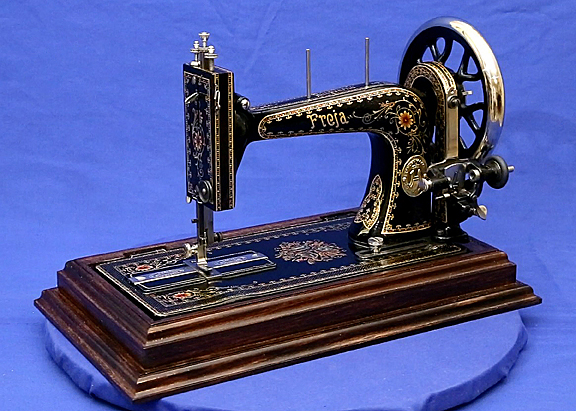
Auntie May is a 1920s-ish Husqvarna Freja (pronounced free-ya) sewing machine. Her actual date could be anywhere from 1883 to 1925, but unfortunately the Swedish Husqvarna company has no early serial number records so she can't be dated. That doesn't stop us from loving this beautiful transverse shuttle machine. She's a close clone of the Singer 12k and still sews a perfect stitch. For a closer look, please click on the following video:
~ Betsy May ~
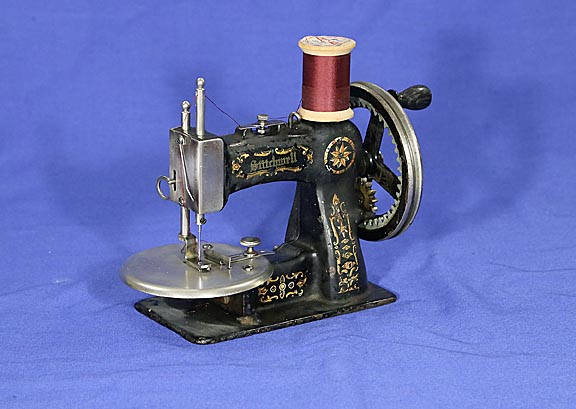
Betsy was made in 1922 by the National Sewing Machine Company. National made thousands of these and rebranded them for whoever wanted them. The Stitchwell brand was for Montgomery Ward. The decal sets were all the same except for the brand name, which was added separately. Consequently, some of these machines have the brand name decal at a slight angle to the filigree decal. All the decals were transparent-paint-over-silver-leaf and must have been brilliant when new.
~ Dani May ~
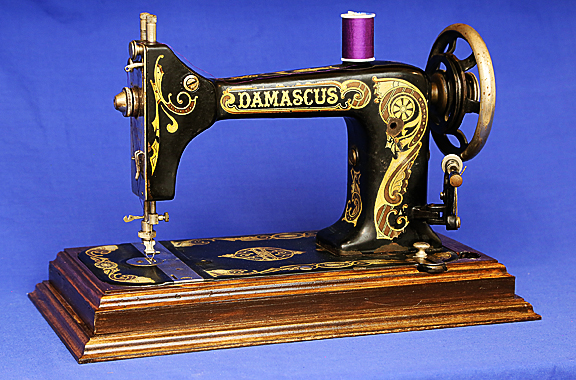
We estimate Dani was made in 1921 by the National Sewing Machine Company for Montgomery Ward. She's a step up in quality from Holly, the National-made Brunswick sewing machine farther down the page.
~ Kasey May ~
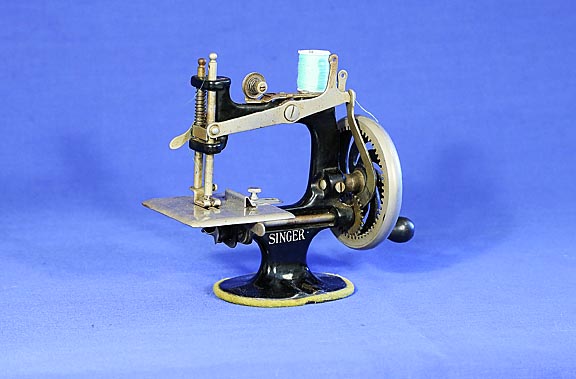
In 1910, Singer released the first model 20 sewing machine, which went on to become the most popular and successful toy sewing machine of all time. Kasey's seven-spoked wheel, tensioning disks and lack of serial numbers date her to between 1914 and 1926. With no other dating information available, we're going for the average of 1920 for her age. She still runs smoothly and sews a tight chain stitch.
~ Peggy May ~
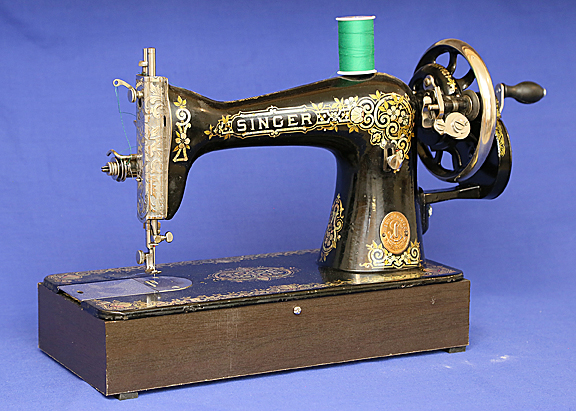
This 1918 Singer model 15K features the attractive Gingerbread decal set. Built to last, she could still be sewing tight seams a century from now.
~ Rachel May ~
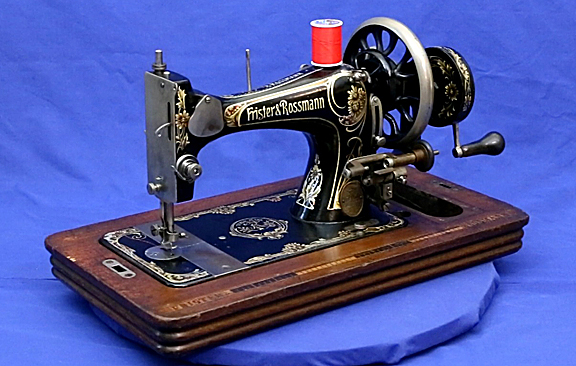
This beautiful German made Frister and Rossmann sewing machine is one of the gems of our collection, not only because of her exquisitely fine decorations, but because in spite of being much more complicated, she runs as smoothly and quietly as the legendary Willcox & Gibbs machine. She dates to 1916. The central decal on her cloth plate should have 'Berlin" in it, but it was removed when it was shipped to Britain because as much as people wanted these outstanding machines, they didn't want anything related to Germany because of the first world war.
~ Mystery May ~
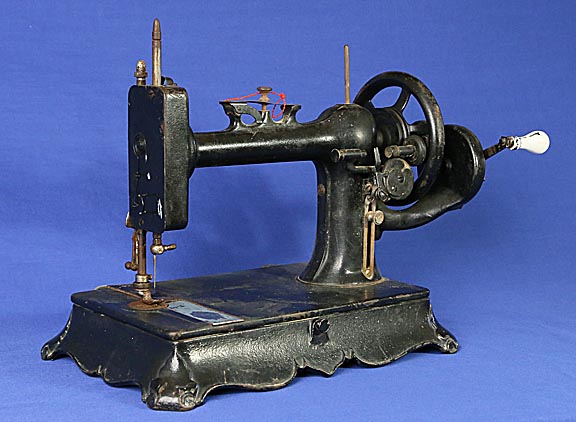
Here we have a New Home model U, also referred to as the New National class. Produced starting in the 1890s and for several decades after that, she's a moderately successful design. We named her Mystery May because when we found her collecting rust in a Salvation Army store she had no identifying marks to provide even a hint of what she was. Spending hours combing through the ISMACS picture archive finally disclosed what she was. Her shuttle access plates, where New Home stamps its serial numbers, have been replaced so we can't date her. We are selecting a date of 1915 because that's consistent with her replacement plates and is in the middle of her production era. These machines were also sold with the Home Companion and Longford names.
Another mystery is why these model Us were manufactured so long and over the same period of time as the more modern type Ts such as Mindy May farther down the page. One final mystery is that she's held on her cast iron base with pivot pins like those used in cabinet machines rather than regular hinges as on all the other versions we've seen on-line. One guess is the New Home made optional bases for machines originally mounted on treadles for people who wanted to be able to store the machine away instead of having them out as a large piece of furniture.
Mystery uses a bullet shuttle in a vibrating shuttle.
Poor old Mystery is a mess. Rust everywhere, jammed parts, a cracked handle, worn and chipped paint, not a trace of her original artwork and a bent and cracked crank arm put her one step short of the landfill. Yet we hope to bring her back to as-new condition. We hope you'll check back from time to time to see how she comes out.
~ Ivy May ~
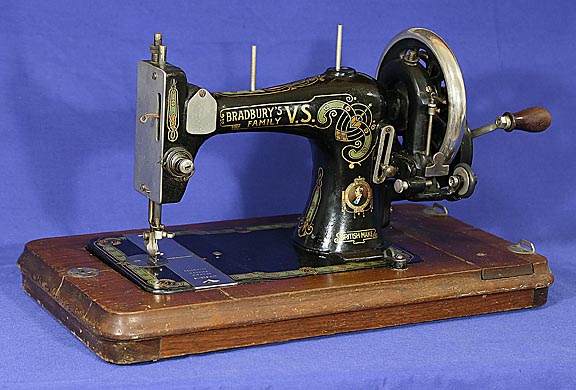
This beautiful 1915 Bradbury features red and green highlights in her gold filigree work. She has a vibrating shuttle. Previous shuttles move back and forth in a straight line. A vibrating shuttle swings through an arc and is a precursor to the modern rotating shuttle.
~ Dolly May ~
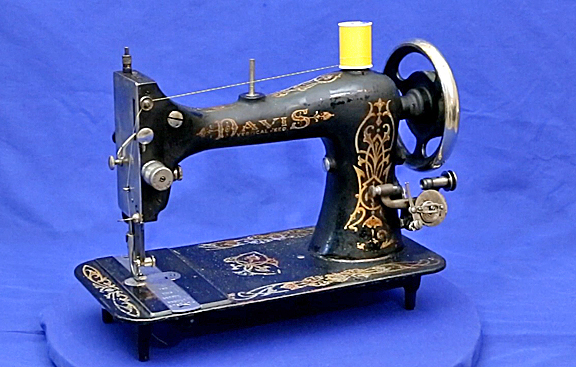
This is a 1914 Davis vertical feed sewing machine. Instead of a dog foot under the needle plate to move the fabric to the rear, it has a finger that follows the needle down and presses the fabric against the needle plate, then both this finger and the needle move backwards to move the cloth into position for the next stitch. These vertical feed machines are favored by quilters because they lock all the layers together so they can't slide relative to each other.
~ Nefretiti May ~
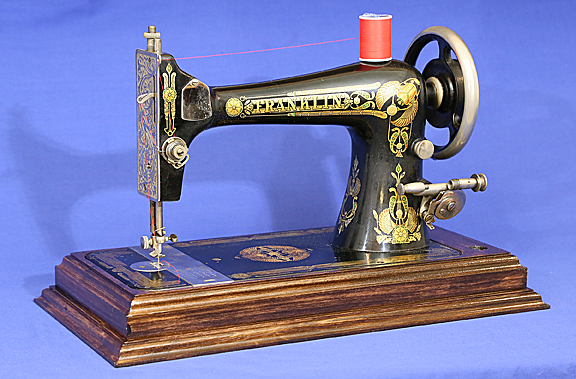
The Franklin was manufactured by the Domestic Sewing Machine Co. (bought out by White in 1926) for Sears from 1911 until the 1930s. Her Egyptian styled decals are an artistic paraphrasing of Singer's Lotus decal set, also designated set #09. She's similar to a Singer model 27.
~ Holly May ~
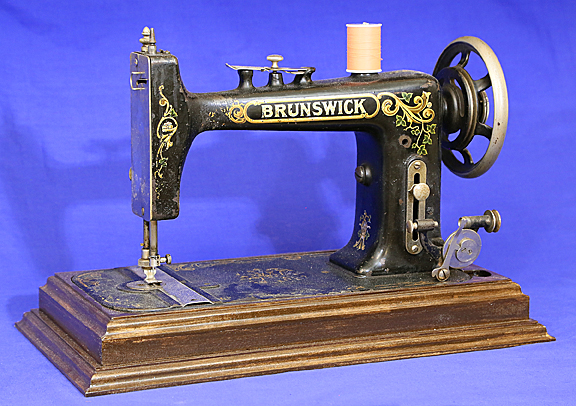
This May sister is a 1913 Brunswick, made by the National Sewing Machine Company for and sold exclusively by Montgomery Ward. Over a century of use and decades of sitting around left her badly jammed with thick layers of congealed oil. Still, with a lot of degreaser and a little hammering to break things loose she now sews great. Next, we have to restore her beautiful transparent-paint-over-silver-leaf decals. Streaks of rainbow color splashed over the letters of her name create a stunning opalescent look that will be a real eye catcher when redone.
NEW!!!
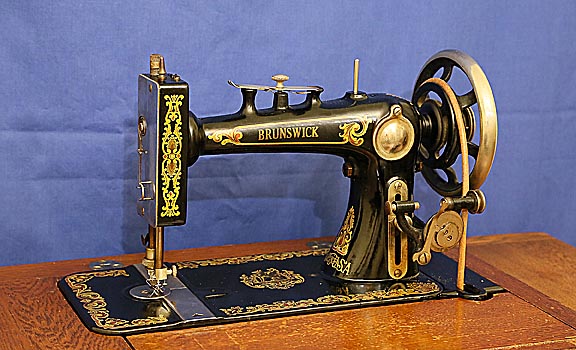
Leah is identical to the previous Brunswick, except that she's a 3/4-size version. This suggests the Brunswicks made by National for Montgomery Ward referred to a class of machine, rather than a specific model. She dates to 1912 and because of her smaller size and cleaner decals, looks more elegant than she larger sister.
~ Bessy May ~
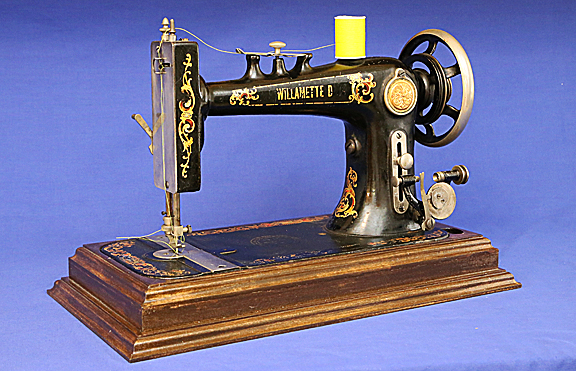
Dating antique sewing machines is often a combination of hunting and guesswork. In this case, the name may provide a clue. The Willamette D sewing machines were made by National for the Portland, Oregon-based chain of Meier & Frank department stores. While she has a serial number (2,296,351) there are no known lists of National sewing machine serial numbers and production dates, so that by itself doesn't help much. But, when compared to our other National machine, which has a 2,167,857 serial number and was dated to 1913 by other means, it suggests this Willamette D is slightly later, say around 1914. Additionally, assuming the name refers to the town of Willamette, which only existed from 1908 to 1917, this date seems to be reasonable.
Bessy (named after the lady who first owned her and handed her down through two generations before her granddaughter entrusted her to our care) is a VB-TT (vibrating shuttle - top tension) type 5 machine who still works after 105 years. After a little polishing and decal restoration she'll be a real gem.
~ Lilly May ~
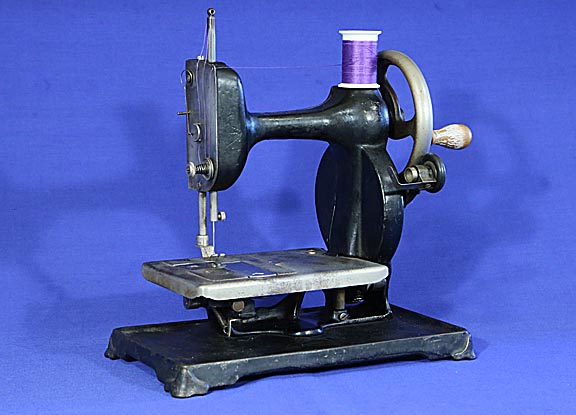
Lilly is a New Home Midget sewing machine from 1912. She was marketed as 'The Little Worker.' Unlike other machines of her size, which were chain stitchers, Lilly is a true lock stitch machine with a swinging, or vibrating, shuttle. To accommodate the shorter, tighter arc the shuttle has to transverse her shuttle is shorter than those of full sized sewing machines.
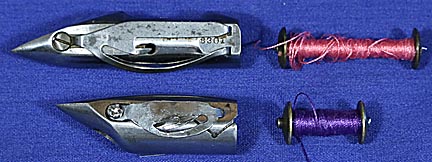
On
the bottom are Lilly's shuttle and bobbin
compared
to a standard shuttle and bobbin on top.
For all her charm, Lilly can be tricky to thread and is easily unthreaded, partly because she doesn't use pigtail thread guides. The following video shows what she looked like before and after her restoration:
~ Sally May ~
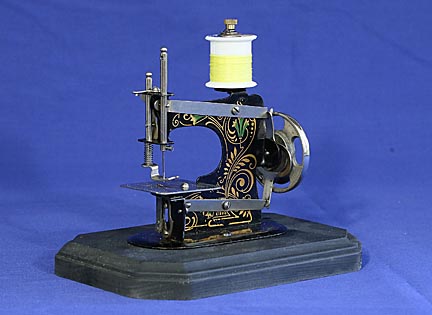
This is an early Muller model 2 chain stitcher dating from 1912. Interestingly, the cam drive on this end-crank machine isn't as smooth as much simpler front crank machines such as Suzy May.
This machine came with an elaborately decorated box that contained: extra needles, spools of thread, key, thimble sized for a young child and a tape measure geared to a dial indicator.
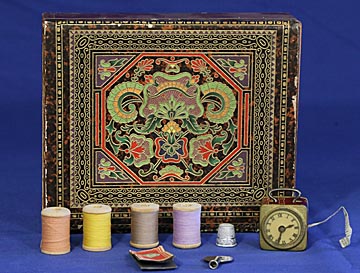
~ Elly May ~
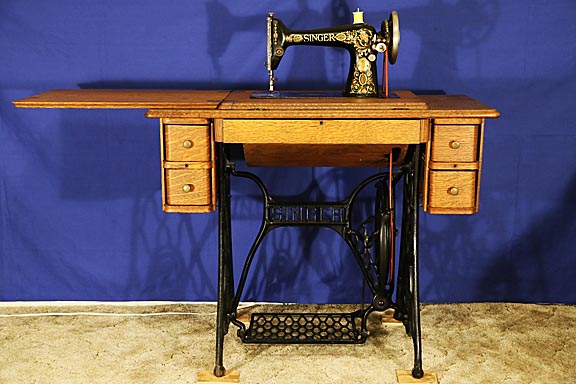
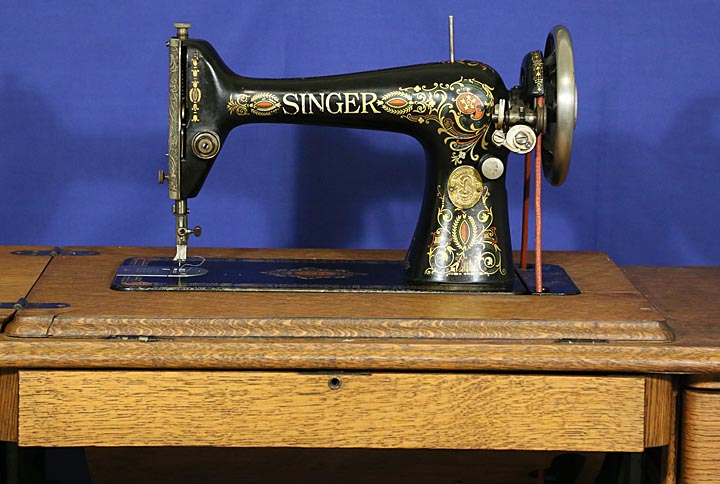
This Singer Model 66 treadle machine first saw the light of day in 1910. The fact that after 110 years she still sews perfect seams is a testament that back then things were made to last. Using a treadle machine isn't as easy as it appears. It takes time to learn the proper rhythm to keep the machine rotating in the proper direction. She uses a bobbin and case similar to modern machines but like Anny May they feed in from the end.
NEW!!!
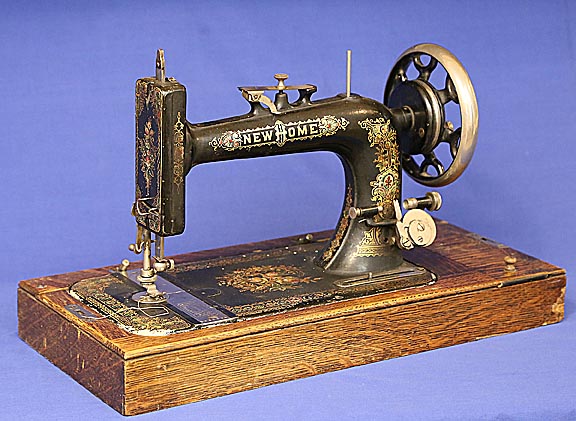
Nancy is a 1910 New Home (later Janome.) Although it can't be seen in the above image, the fact that her hand wheel does not have a second hole suggests she's a model A3. Nancy still sews great after 110 years.
~ Missy May ~
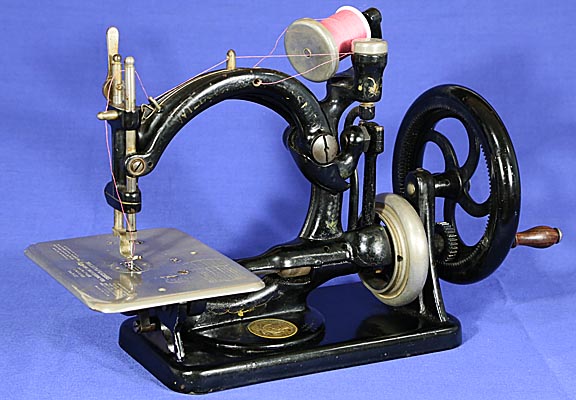
Missy is a 1910 Willcox-Gibbs chain stitcher on an American hand crank base, which is much rarer than the more common British hand crank attachment mounted on Lizzy May, two machines farther down the page.
Here's what she looks like after restoration:
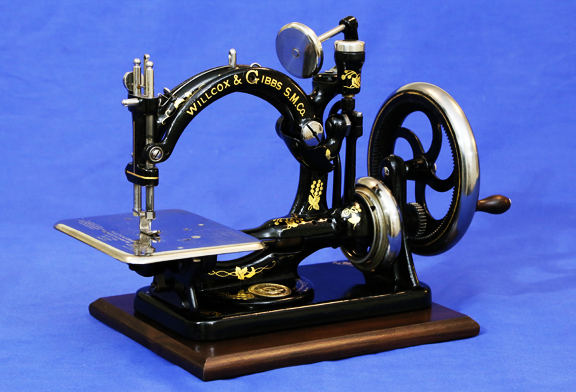
And here's a view of her main wheel:
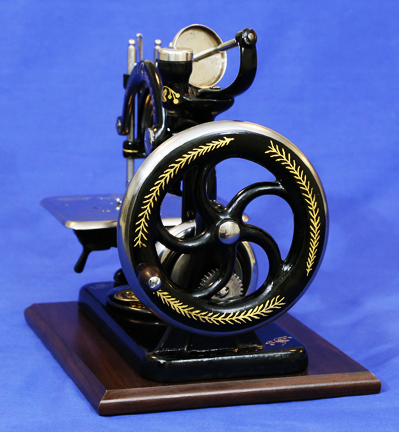
It's interesting that while all the artwark on the machine are lithographed decals, the wheel was done in hand-applied gold leaf.
~ Mindy May ~
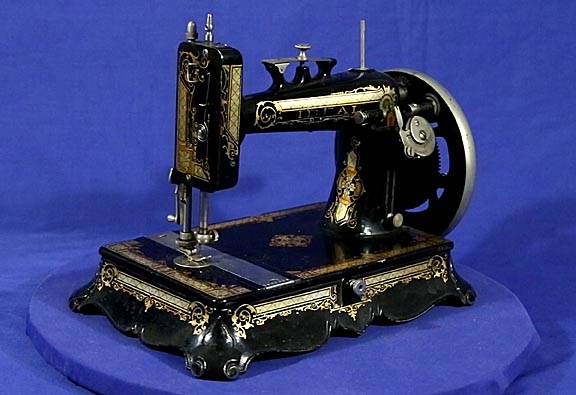
Here we have Mindy, a 1908 New Home (later becoming Janome) lock stitch machine bearing the model name IDEAL. Her decals are in very good condition and better still, she still sews a tight lock stitch. New Home rebranded similar machines with a wide range of names, such as: Climax, Ever Ready, Gilchrist, Lady Washington, Winner and New Ideal. Mindy is a model T, as indicated by her body shape, type 1, as indicated by the large main wheel. Later types 2 and 3 had smaller wheels.
~ Lizzy May ~
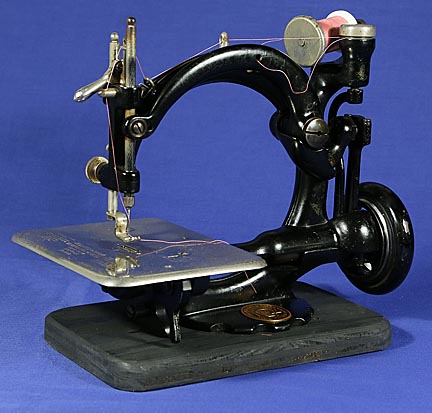
While her small size might create the impression that she's a toy, this 1907 cast iron machine by Willcox-Gibbs is built rock solid and after 110 years is still the smoothest and quitest of all the machines in this collection. In fact, when first marketed she was advertised as being, "The Silent Automatic Sewing Machine." She's a chain stitcher with an unusual threading system that makes her the hardest to thread of all the machines. While she can be used in a hand crank mode, she's actually designed for use on a treadle. One curiosity is that her main drive wheel rotates in the opposite direction of all other machines.
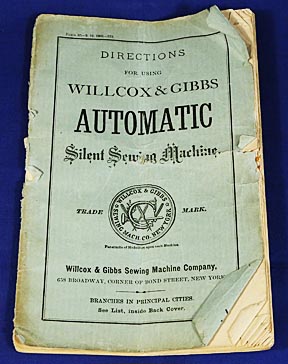
A remarkable survivor that came with Lizzy May is her original manual, printed in 1905.
Here's a short video showing her before and after her restoration:
And here's an update video showing her sewing with a restored handcrank:
And here's yet another video comparing Missy's American to Lizzy's British hand crank:
~ Violet May ~

Violet is an absolute gem. Named for the subtle purple violets adorning her early transitional art deco decorations, this German made machine from the Dietrich Vesta company is slightly larger than the Vesta Saxonia shown earlier. Vesta machines can be dated by the form of the badge riveted to the vertical arm, in Violet's case 1896 to 1914. In the absence of better information, we're dating her to 1905 because her artwork combines aspects of the earlier Victorian forms as well as hints of the new art deco style, which would has been more prominent by the 1910+ years. This is just a guess and we'll update when better information becomes available.
She's a transverse shuttle machine with a needle that threads from front to back.
~ Zoey May ~
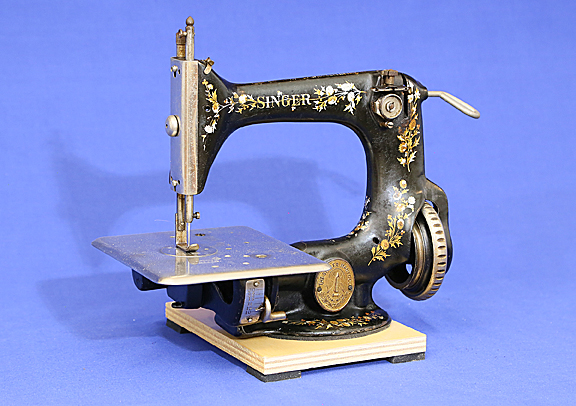
This 1905 Singer model 24-26 industrial sewing machine has an interesting story. At the turn of the century the war over which was better, lock stitch vs chain stitch, was still very active. The battle cry: "Why use two threads when one works as well," was shouted by chain stitch enthusiasts everywhere, particular in the mass production of clothes where the simpler system saved time and money. The famous Wilcox and Gibbs chain stitchers were so successful Singer decided to jump into the foray by releasing the model 24, the only chain stitcher they ever released. It was an instant success because, unbelievably, it ran even quieter than the W&G, important when there are over 100 them cranking away in a single room, was easier to use, just as reliable and required less power. All in all Singer released nine different models of the 24: some for domestic use but most for manufacturing. Zoey is an industrial model as indicated by the absence of anywhere to hold a spool of thread. This was because it was designed for the spool holder to be mounted on its table so it could hold manufacturing-sized spools. What we can say fro our experience is that as good as the W&G machines are, Zoey sews a much tighter and more even stitch, and that's impressive.
~ Kelly May ~
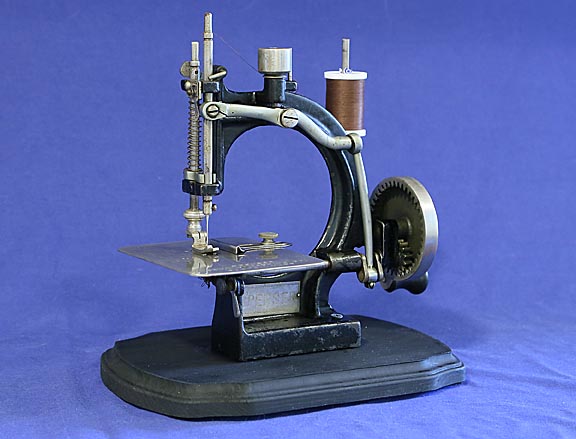
Dating from 1902, Kelly May was manufactured by the Spenser Sewing Machine Company of Boston Massachusetts. She was sold as the "Automatic Hand Sewing Machine." The large silver knob at the top of the machine is an automatic tension controller. However, we have yet to figure out how to use it because it offers no advantages over other machines that don't feature such a system. This model is reported to be a copy of a Smith and Egge 1897 "Little Comfort Improved Sewing Machine."
~ Amy May ~

Amy is a 1902 Singer model 28K In near pristine condition. You almost need a magnifying glass to find any wear on her decals. Even though she's 110 years old, she still sews a sweet stitch.
~ Suzy May ~
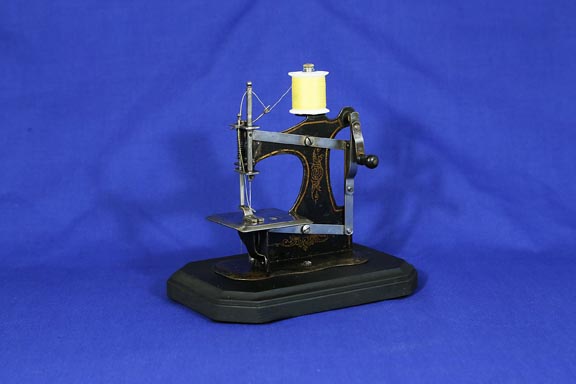
This Muller Model 1 toy sewing machine could have been made anywhere from 1880 to 1910. The simplicity of her decorations suggests she's an earlier model, but we're being conservation and listing her manufacture date as 1900. Three things differentiate Suzy May from all other machines. First, the cloth moves from back to front instead of front to back. Second, the hand crank operates parallel to the side of the machine rather than perpendicular and at the end. Finally, the foot that moves the cloth is above the needle plate instead of below it.
NEW!!!
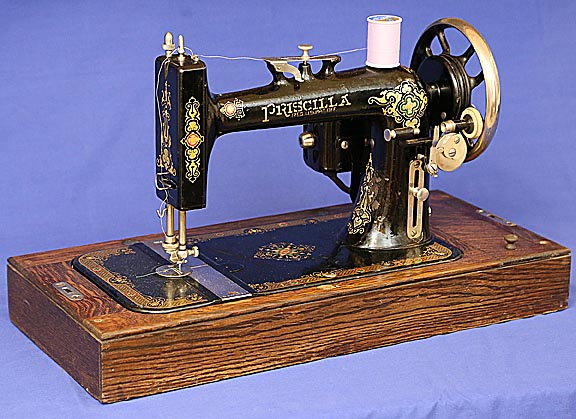
Sweet Priscilla is a 1926 New Home (later merging with Janome) model R2 electric sewing machine. The R1s were the same unit without an electric model and date much earlier. She was also badged as The Ruby and The Greyhound.
~ Izzy May ~
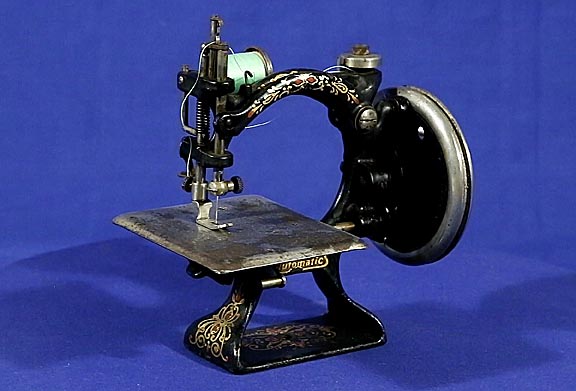
Izzy was made by Foley & Williams in 1899. Sized closer to a toy, she was sold as a lightweight, inexpensive alternative to full sized machines. Note that while she's set up as a hand crank machine, her main flywheel has a groove in it for a belt so she could be mounted on a treadle base. She sews fine and although her metalwork needs a lot of work, her decals are 90-percent perfect.
NEW!!!
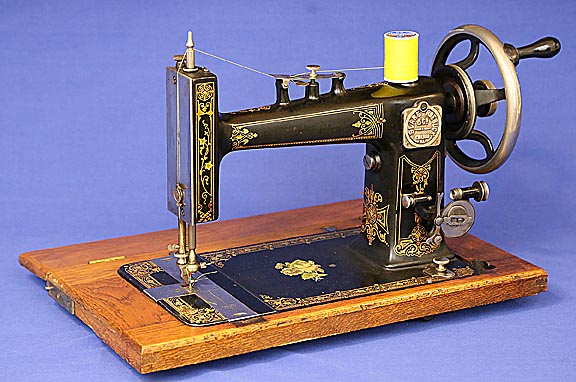
Elsie's an interesting machine because although it can't be seen in the image above, she's badged as The Burdirk, as the following image in ultraviolet light shows:

We've traced her to 1899 from the Illinois Sewing Machine Company. The problem with researching her is that several companies sold models labled The Burdick, which is much easier to pronounce. Search engines always want to focus on this name rather than ours. She's a model K and uses 20x1 needles, like a Boye 24. This same model was badged as The New Royal, The Acme and The Steletto. Elsie has a very squarish, straight-up form that helps her stand out from all of the more common rounder machines. Her decals are in great condition. All she needs is a good cleaning and polishing and she'll be a reall stand-out.
~ Cleopatra May ~
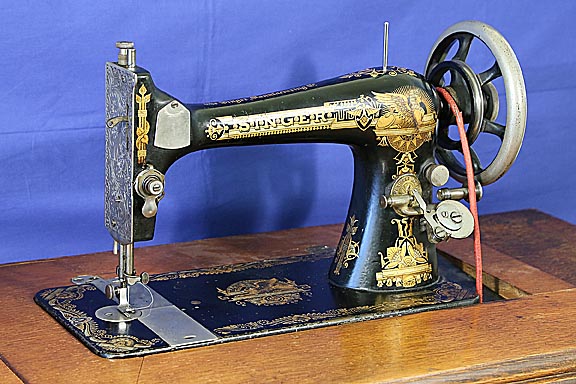
My wife and I were strolling through a quilt show one day when over in the corner we spotted a stall selling various quilting odds and ends. To our amazement, one of the tables being used to display items for sale was this beautiful 1899 Sphinx sewing machine by Singer. When we asked about it, we got our second surprise: It was for sale! We snapped it up on the spot and boy, were we lucky.
Cleopatra (given her Memphis Egyptian decal set we couldn't name her anything else) is in great shape. She sews smoothly and reliably, there is no rust and just a little tarnish. Best of all, her decals are in excellent condition.
Sadly, the popularity of this machine is such that modern reproductions are common. Fortunately, this one's an original as proven by the absence of any 'Made in China' or 'Made in India' casting marks on the underside of the base. The treadle cabinet is also original as can be seen by the patina on the wood on the undersides of the drawers.
She's our new pride and joy.
~ Eliza May ~
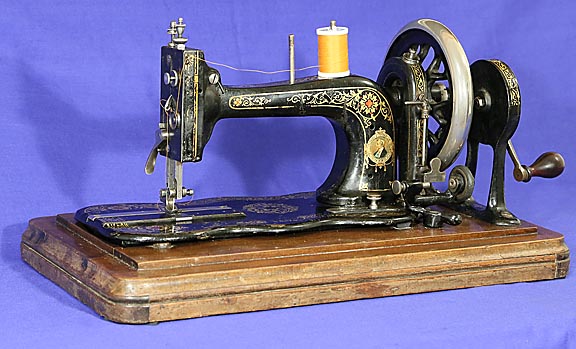
Eliza was born in 1895 in the Bradbury Sewing Machine factory in England. She uses the rare and expensive-to-replace boat-type shuttle and bobbin holder than can cost $100 to replace... if they can be found at all. Replacement is complicated by the fact that there are several different sizes of boat shuttles and little information on which size fits into any given machine. Note her curved base, which marks her as a fiddle-base machine. While her needle holder can accommodate modern needles, their large diameter shanks cause the point to move enough forward and to the left to cause problems. She prefers thin, straight shanked needles with the shank the same diameter as the needle itself. One of the great and as yet unsolved mysteries about this machine is how to attach the coffin cover that fits over her base. It's secured with a threaded rod that passes through a bar across the middle of the lid and secured with a wingnut. But there is no hole anywhere on the base of machine to receive the lower end of the rod. We've contacted several experts and none of them know how the lid is mounted.
While Eliza was made on an assembly line with supposedly interchangable parts, swapping parts with another machine of the same model may not work. For example: If the bobbin winder from the following machine is put on Eliza, it won't allow the leaf spring to lock it in position against the main wheel.
These winders have an automatic release action that disengages the winder from the main drive wheel when the bobbin is full.
~ Melany May ~

Melany May is an 1893 Bradbury identical to Elizy May except for simpler appliques and showing much greater wear. She is, in fact, a complete mess. But take heart. I have great plans for her. Because she is in such poor condition she has little or no value to collectors. Poor Melany can't even be used for spare parts because many of them are coded for this unit. Transfering them to another machine would decrease its value in the same was that a made-up antique gun with serial numbered parts that don't match is worth less than one with all the same numbered parts. Consequently the rule that an antique should never be refinished doesn't apply. My plan is to take her down to bare metal and refinish her from bottom to top with all new paint and appliques. Pretty soon she will blossom from the ugly duckling into a beautiful swan. I hope you'll check back from time to time to see the result.
~ Beverly May ~
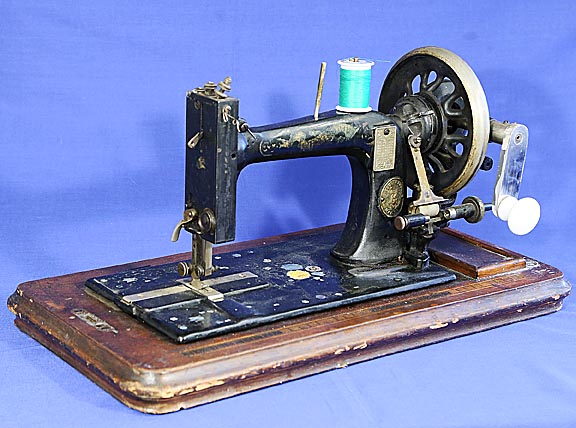
If poor old Beverly May looks like a mess... she is. The seller didn't pack her properly for mailing and she arrived with the box half ripped open, parts falling out, several metal stems bent, broken and missing and worst of all her handle was broken off and had fallen out of the box. (I made the one in the image.) Internally she's not much better. Over a century's grime and dried oil have built up to make her almost impossible to turn. Still, this rare 1888 Biesolt and Locke sewing machine is worth the effort of a top to bottom restoration, mainly because she's the only full sized hand cranked sewing machine with a front facing crank. Another rarity is that she's one of the few machines boasting the waving-ribbon Cinderella decal set.
~ Melody May ~
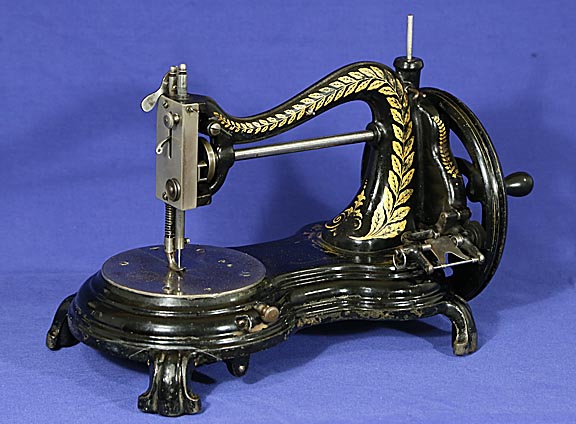
Melody is a Jones Swan Neck sewing machine and hails all the way back to 1888. While every machine so far has a rubber wheel running on the main flywheel to drive the bobbin winder, Melody has a felt wheel impregnated with a material to maximize friction. Sadly, the felt has worn down to the point where hand pressure is needed to wind a bobbin. We found stretching a small, wide rubber band over it solved the slipping problem so we don't have to hold it against the main drive wheel by hand.
Melody's restoration came out great. If you'd like to see what she looked like 130 years ago when she first rolled off the assembly line, please click on the following video:
~ Hilda May ~

While she may not be the oldest machine in the collection, Hilda May was the one that started everything in motion so we think of her is the matriarch of the May sisters. Made in 1896 (serial number 21,908), this British-made Jones Family C.S. (which stands for 'cylindrical shuttle') type 4 hand cranked sewing machine still works perfectly, an amazing accomplishment for something over 132 years old. While she may look like Singer machines of the same era, she features several different drive mechanisms that avoided Singer suing over patent infringement. Using hand cranked sewing machines requires more dexterity than modern machines because you only have one hand to guide the cloth, while the other turns the crank. This is more difficult than it sounds. It's rather like trying to pat your head and rub your stomach at the same time.
An interesting side note about the Jones sewing machine company is that they would manufacture machines and if requested, put retailer's labels on them for resale. Singer, on the other hand, insisted that all of their machines be sold under the Singer name.
~ Madeline May ~

Next we have an 1883 Wheeler and Wilson Model 8, which has a form similar to the 1875 American a few machines farther down the page.
~ Shirley May ~
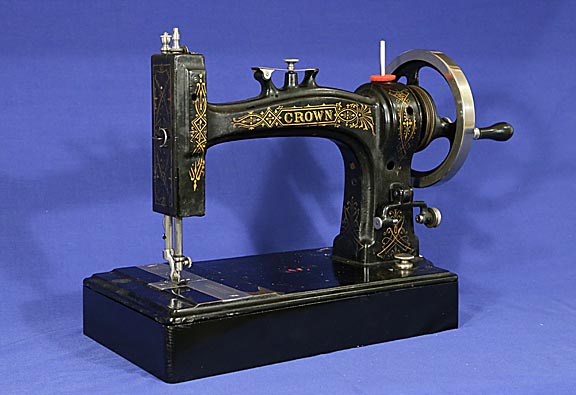
Crown sewing machines are extremely rare because they were manufactured only from 1880 to 1883 and only in small numbers. They were made by the Florence Machine Company, which was originally the Florence Sewing Machine Company, maker of the famous and much sought after Florence sewing machine. The company changed its name in 1877 (or 1879 depending on whose history is referenced) to reflect the fact that it had expanded its product line far beyond sewing machines. Taller than most machines in its class, the Crown has an attractive form helped by the concave fullers in the edges of the main body. Designed for treadles, this unit has been fitted non-destructively with a base and handle for hand operation.
~ Emmy May ~
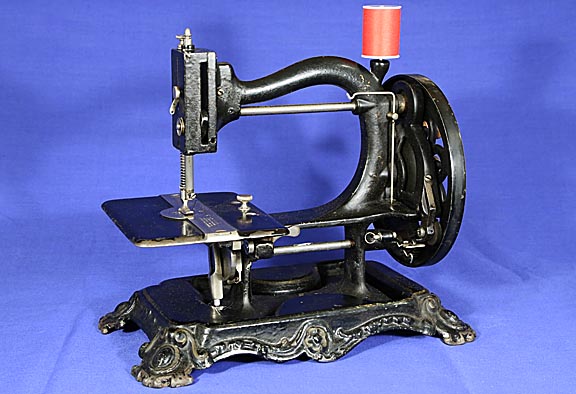
This Wanzer Model A antique sewing machine is over 138 years old and still sews a great lock stitch. She uses a linear shuttle instead of the earlier vibrating shuttle like those used in the Little Wanzers, so she has to be no earlier than 1875. Additionally, she has the improved bobbin winder, which came out in 1878. From these two dates and a few serial numbers we found on-line we've concluded that Emmy first left the factory sometime in 1880. These model A's were only produced through 1883 and not in great numbers because they weren't very popular. Consequently, they are rare compared to the Little Wanzer, of which well over a million were made. Mechanically she's in perfect shape, with the exception of a non-original handle screwed into a new hole drilled and tapped into the main drive wheel. This issue is easily corrected. One fortunate discovery is that a Janome #11 blue shank needle works perfectly in her, unlike the earlier Little Wanzer, which required a longer, thinner needle.
The greatest challenge is going to be restoring her artwork, which is almost completely worn away. Repeated on-line searches have yet to turn up any Wanzer A sewing machines that have either been restored or machines in original condition with enough detail to show what they are supposed to look like. But, we've come up with a few tricks for recovering long faded artwork that give us hope that one day soon Emmy May will sparkle as brightly as she did when she first saw the light of day. To see how her lost artwork can be recovered, please click on the following very short YouTube video:
~ Heidi May ~
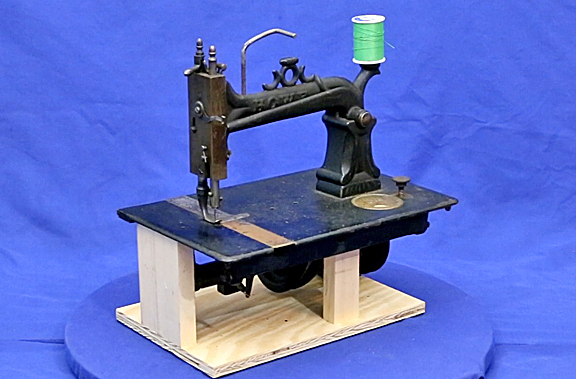
This 1879 Howe needs a lot of work, but isn't in near as bad a shape as...
~ Hailey May ~
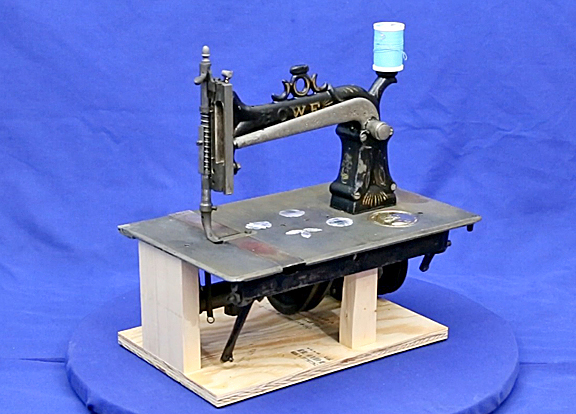
... poor old Hailey May, who was little more than a pile of rust when we got her. She's missing so many parts that we bought Heidi so we could figure out how to make replacements.
UPDATE!!!
We finished her restoration in early 2020. Click on the following link to watch a before-and-after video of her transformation from disaster to one of the most beautiful machines in the collection:
And here's a follow-up video showing how to sew on her:
NEW MACHINE!!!
~ Margaret May ~
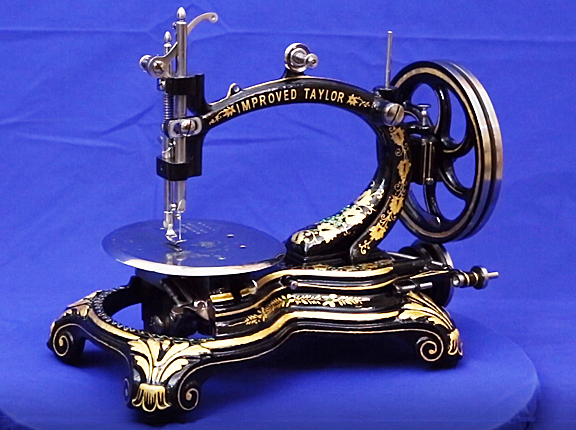
This 1877 Improved Taylor uses a unique metal-on-metal friction drive between the main drive wheel and the lower drive arm. The intend was to eliminate the belt used in every other machine. Sadly, it was a failure. When transitioning from thin material to thick, it would often slip. The earlier and otherwise identical cross belt drive Taylors were outstanding in every way, earning more than 15 gold medals in international exhibitions. Sadly, in spite of their outstanding quality, the Taylor company closed its doors in 1882 after very few years of production.
While her decals are in excellent condition for a machine that's 144 years old, she has one blemish that's very interesting.
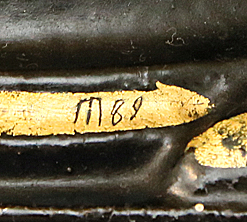
Someone scratched 'M 89" into the gold paint in an out of the way location. We're assuming the very small size of the mark indicates it wasn't a child, since they probably wouldn't have been careful to make it so small, choose to place it where it couldn't been seen and have the dexterity to make such tiny marks. Our thought is that 14 years after the machine was purchased, the original owner passed it on to her adult daughter, who put the first letter of her name and the year she received it to mark it as her own.
Another unique feature of the Taylors was that instead of using vibrating shuttles, in which the shuttle moves in an arc, or linear shuttles, where they move back in forth in a straight line, the Taylors moved their shuttles in an ellipse. This near-circular motion was advertised as producing a smoother, quieter movement. For a live action review of this great machine, please watch the following video:
~ Angelica May ~
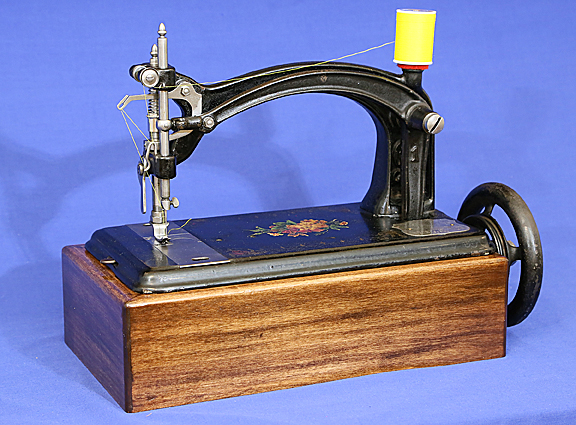
This 1875 sewing machine is a model 1 made by the American Buttonhole, Overseaming & Sewing Machine Co. of Philadelphia, Pennsylvania. Designed for a treadle, its unique low-humg flywheel and pulley make her difficult to fit into regular treadles tables, which is probably why we got her for a song from Ebay. She's 144 years old and still sews great.
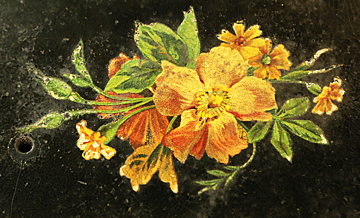
A close-up of her hand painted decoration.
Here's what she looks like after 120 hours of restoration:
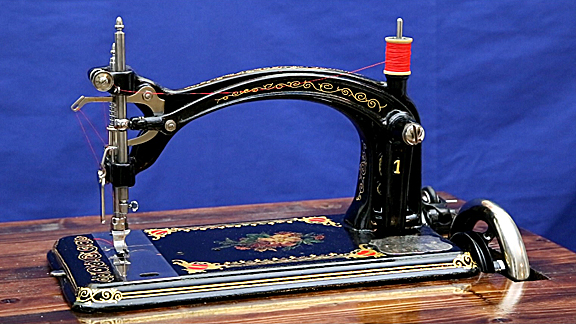
Mounting her on a treadle table emphasizes her low, sleek, graceful lines. She uses a tiny bobbin similar to modern bobbins held in a vibrating shuttle. Angelica sews like a dream: never tangles when picking up the bobbin thread, sews a tight lock stitch and in all the time we've used her has never dropped a single stitch.
To see her in action, please click on the following link:
~ Tilly May ~
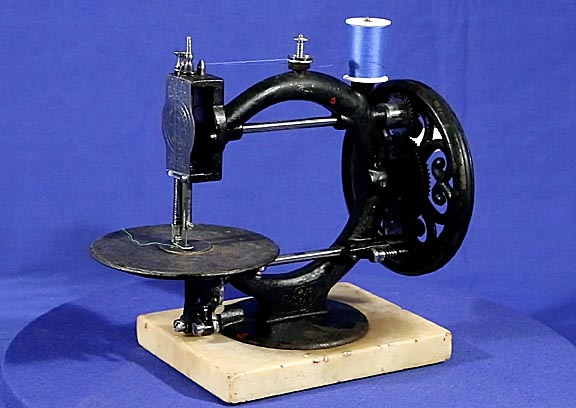
Little
Wanzer sewing machine before restoration but after her brightwork
had been polished
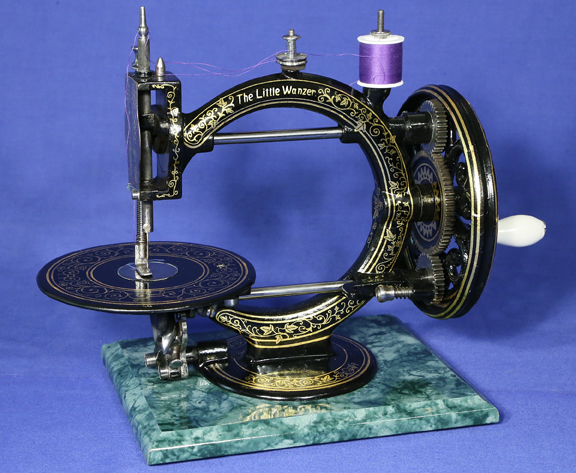
Little
Wanzer Sewing Machine After Restoration
Tilly is a rare 1871 Little Wanzer sewing machine. She represented one of the most challenging restorations we ever attempted. The first image shows her after all her metalwork had been polished, but when we got her rust covered everything. Her finish was completely destroyed, in fact the circular cloth plate looked like someone had taken an angle grinder to it. Only a very few faint traces of her gold decorations remain. And that's the good news. The bad news is that she was missing her shuttle and bobbin (these are a special small size and can't be replaced,) many pins and screws were missing, her needle was gone and we had no idea what size she took, and worst of all, the gear that drives the needle head up and down was broken so that it slipped on the drive shaft without turning it.
In spite of all these problems as you can see in the second image, the restoration came out great. We replaced the missing screws, found a needle that fit her, made pins to replace those that were missing, figured out how to repair the broken gear and believe it or not, made a new shuttle out of, of all things, the end of an old crowbar.
The clothplate and main gear don't show up very good in the restored image so here are close-ups of them:
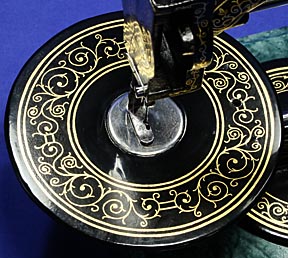
Little
Wanzer Cloth Plate
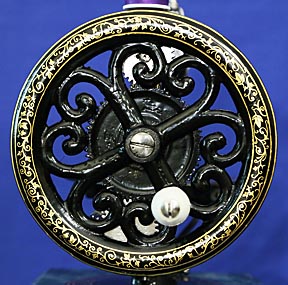
Little
Wanzer Gear
Please click on the following video to watch the restoration:
~ Audrey May ~
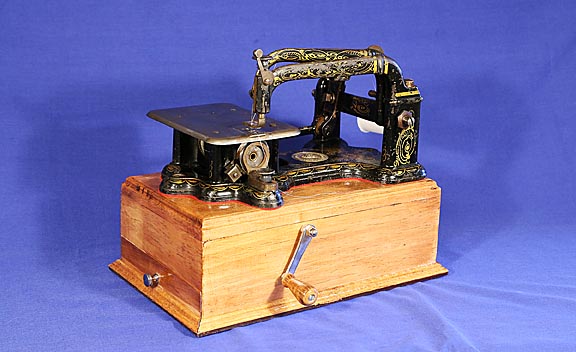
This Wheeler and Wilson Model 3 Sewing Machine is one of the treasures of our collection. Her brass medallion indicates she was made after 1870, while her 766,004 serial number locks her into the middle of 1872, 146 years old as of 2018. Audrey's a lockstitch machine with a bobbin that looks like two small Frisbees stuck together. Designed for a treadle with a 1.25-inch wide strap belt, here she's mounted on a box with a hand crank. Ninety-percent of her gold artwork is in still in excellent condition but because it's hand painted, restoring the worn 10-percent is going to be a challenge. To eliminate the lever action required to move the needle straight up and down, Audrey has a long needle arm with a curved needle. These needles are extremely rare and can cost $30.00 each... if you can find them at all.
One of her most unique features is a clear glass insert in the presser foot. This enabled early sewers to see the stitch clearly enough to stitch extremely close to the edge.
NEW MACHINE!!!
~ Mary Anne May ~
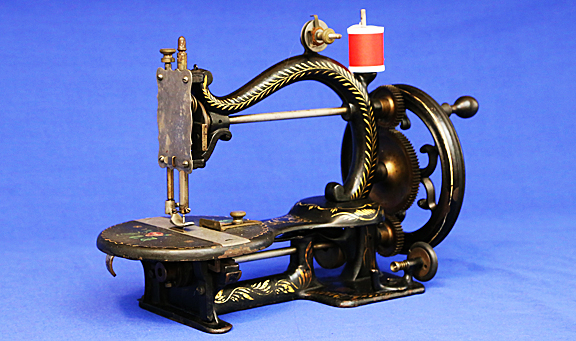
If you like antique sewing machines you're going to have a hard time not falling in love with little Mary. She's an 1869 Home Shuttle sewing machine, sometimes also branded as the Gold Medal sewing machine. Shortly after her release, the company renamed itself New Home and eventually merged with Janome.
Beautiful in both form and decoration, her hand painted shell gold artwork is 95-percent complete, remarkable considering she's seen 121 years of use. Unlike many early hand painted machines, Mary's exhibits an exquisite fineness and refinement, indicating she was painted by a master of the art.
The following video shows what she looks like after restoration and how to sew with her:
In honor of her restoration, we've rechistened her, 'Mary Anna May.'
~ Flora May ~
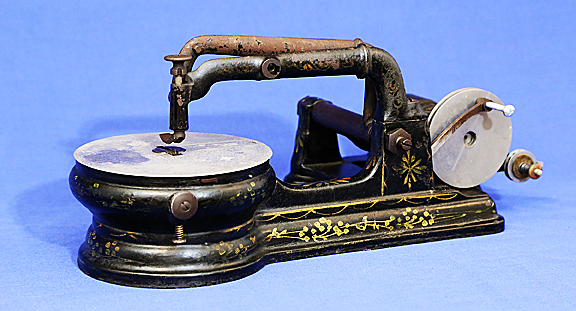
This Florence sewing machine was manufactured by the Florence Sewing Machine Co. in 1869. Like the Wheeler and Wilson, she uses a curved needle because the stitching arm moves up and down in an arc. A straight needle would stretch its hole into a football shape. Rare and expensive, we god this one for one-third the usual price because she's in such poor condition. But that's perfect because by carefully restoring her we figure we'll add enother century on her life. Without restoration, sadly, about all she'd be good for is spare parts or the landfill.
~ Lory May ~
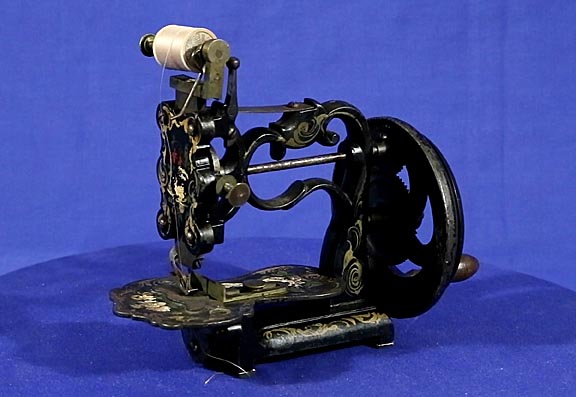
Lory is a small, 1867 sewing machine made by the A.F. Johnson Company, one of a dozen small New England makers in the early years of sewing machine manufacturing. There's a chance she could be as early as 1861. We're still researching the company to lock the date down. Similar in style to the Weir machine coming up next, she's slightly smaller and doesn't run quite as smooth. Still, she's a sweet addition to the collection.
~ Mandy May ~
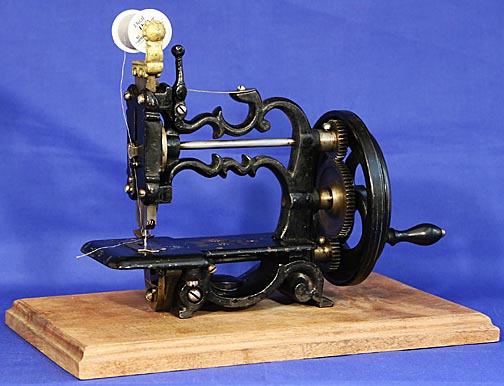
Hailing all the way back to the very early 1860s, Mandy May is a chain stitcher that was sold by the James Weir Company in London, England. Originally titled, "The Globe," she was presented to the US as, "The American Hand Sewing Machine" and represents one of the very earliest sewing machines made for home use. Prior to that, sewing machines targeted commercial use because their cost was too high for most people to afford.
One unique feature is that the thread spool rides on the armature that holds the needle. This means the spool moves up and down with the needle. It looks odd but makes her the easiest machine to thread because the thread goes straight from the spool into the needle. A downside to this system is that the armature's weight makes the wheel slightly easier to crank when the armature is moving down than when moving up. This fluctuating resistance to turning the crank isn't significant enough to be bothersome, but it does feel a little odd.
Mandy May is over a century and a half old and it's entirely possible that she may have sewn Union or Confederate uniforms during the American Civil War. She's truly a treasure from the past.
Up until the late 1950s, most sewing machines were straight stitchers. To extend their capabilities, there was a very active industry developing elaborate attachments. The following are just a few examples:
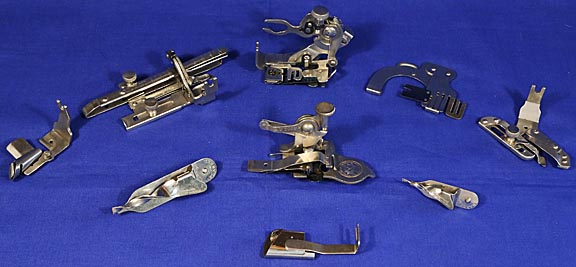
Many were developed by individual inventors. In a way, these attachments played the same roll for sewing machines back then that modern aps do for smart phones.
I
hope you've enjoyed this tour back in time.
We're
still looking for and collecting vintage sewing machines so
be
sure to check back from time to time to see the latest additions to
the May sisters.
For
a live-action version of this page, please click on the following
YouTube videos:
Return to my main page to browse 60 other subjects